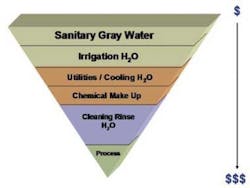When Size Really Does Matter
Compact drinking water units are proving their worth across Africa, especially in emergency situations. Laurent Dolleans discusses the process of the UCD unit and how they have increased drinking water supplies in Algeria and Brassaville, without the need for major engineering work.
The supply of drinking water is a major challenge for developing countries, especially when faced with emergency situations. Objectives in such times are to quickly supply populations with sustainable drinking water solutions. Short delivery and commissioning times are crucial.
Certain solutions offer access to drinking water without requiring major engineering works or special technical expertise to help install them.
For example, with Degrémont Technologies' compact UCD units, the company will supervise the assembly and commission of the units once the civil engineering works are finalised (concrete slab and pumping). Local teams also undergo training so they can help manage and maintain installations.
In order to comply with localised constraints of the areas concerned, each project is conducted in partnership with a network of local service providers.
Studies are then carried out on the quality of the water to be treated, to ensure the drinking water supply meets international standards defined by the World Health Organization.
Requiring low power, the UCD process design integrates a coagulation-flocculation chamber, a settling area, and pressure filtration with water and air scour backwash. The civil works required for installation are confined to a concrete slab and drainage pipe connected to the sewer. The UCD drinking treatment plant is based on a compact conventional process: coagulation, flocculation, lamellar clarification, sand filtration and chlorine disinfection.
Sludge extraction is automatic. This automation is based on relay type actuation, which is very simple to maintain in remote areas. Several options are available taking into account water treatment requirement (automation with PLC, aeration, pre-oxidation, UV, active carbon filtration, etc.) and chemical reagents available in the country. So how does the process work?
After a coagulant is applied, the raw water flows into a flocculation chamber to increase the size and cohesion of the floc. A clarifier equipped with lamellar modules is used to accelerate the separation of the floc. Sludge stored in the lower position of the separator is withdrawn automatically at regular intervals.
Water is then transferred from the flocculation compartment to the settling tank via a stilling chamber located beneath the lamellar modules. Settled water is collected in the settling tank overflow and pumped to the filters. Inside the filters, water is distributed above the filter media and flows down through the sand, which traps the suspended solids. Nozzles fitted on the filter floor collect the water evenly. Chlorinated solution is then injected in line to filtered water for disinfection purpose.
Backwashing then uses filtered water from the operating filter, coupled with air scour. This design aims to clean the filter media thoroughly, minimise the duration of the backwash cycle and eliminate the need for a backwash water tank and pump.
Case studies in Africa Algeria: A drinking water supply for Kabylia
Kabylia features very contrasting rugged relief across its landscape, where you very quickly go from plains to mountains. This relief is why the region has major natural water potential. However, it also means that access conditions to the villages are very difficult, which does not make it easy for drinking water supply projects.
Between 2000 and 2009, under the framework of a drinking water access program for the whole population that was launched nationwide, the DHW of the Bejaia and Tizi-Ouzou regions installed four UCD units with a capacity ranging from 50 to 360 m3/h. The units enable river water to be exploited without requiring major engineering works.
The wide range of treatment capacities enable isolated areas with small populations to receive a water supply with reasonable installation costs depending on the number of inhabitants serviced. It has been stated that currently 85 to 90% of the villages in the Tizi-Ouzou region benefit from drinking water supply.
Brazzaville: city modernisation program
In 2008, Brazzaville launched a modernisation program that aimed to help rehabilitate the city's plants, with the construction of new installations and the supply of drinking water to rural areas.
The scale of the city's drinking water shortage gave rise to the establishment of an emergency plan. This saw the installation of Degrémont Technologies' UCD units to face the urgent nature of the issue and to reinforce the drinking water production with equipment that integrated into existing plant.
The installation consists of three units with a capacity of 720 m3/h and 1 unit with a capacity of 180 m3/h. Installed at the two existing Djoué and Djiri plants, the UCD units offer the same treatment process as the existing installations: settling and sand filtration, guaranteeing the same treatment qualities. The units were delivered in the second half of 2008 and commissioned in 2009.
Author's note:Laurent Dolleans is the director of the Packaged Systems Division in Degrémont. For further information on Degrémont's products please see the WWi video interview with Tony Lau, manager of environmental technologies for Degremont: http://www.waterworld.com/index/video-gallery.html
More Water & WasteWater International Current Issue Articles
More Water & WasteWater International Archives Issue Articles

